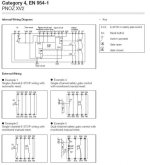Hello Guys,
I was wondering if someone could quickly explain, maybe including a sketch or two, how a typical emergency stop circuit is wired. As far as I know, it should be normally closed and remove power from the PLC output modules and all machine actuators. I believe I had also read that there should be redundancy in the pushbutton wiring, meaning that more than one contact on the same switch should be used in case one should break. I also know that a relay (or a couple, redundancy?) is generally involved, but am not exactly sure where in the process it is supposed to be wired. Is the relay wired in between the +24V power supply and +24V bus connected to the PLC output modules/actuators or something, so that it can disconnect this power completely? Or how should such a circuit be structured exactly? I have also seen specific relays designed for emergency stop circuits, are there any benefits to using these as opposed to a standard contactor or something, for example?
Thanks for any responses!
I was wondering if someone could quickly explain, maybe including a sketch or two, how a typical emergency stop circuit is wired. As far as I know, it should be normally closed and remove power from the PLC output modules and all machine actuators. I believe I had also read that there should be redundancy in the pushbutton wiring, meaning that more than one contact on the same switch should be used in case one should break. I also know that a relay (or a couple, redundancy?) is generally involved, but am not exactly sure where in the process it is supposed to be wired. Is the relay wired in between the +24V power supply and +24V bus connected to the PLC output modules/actuators or something, so that it can disconnect this power completely? Or how should such a circuit be structured exactly? I have also seen specific relays designed for emergency stop circuits, are there any benefits to using these as opposed to a standard contactor or something, for example?
Thanks for any responses!






